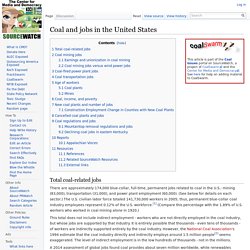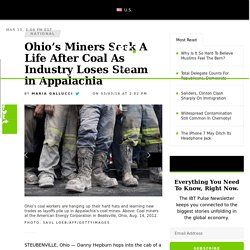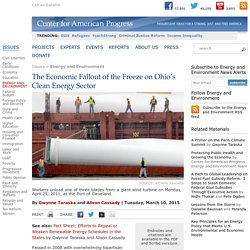

Clean-Energy Jobs Surpass Oil Drilling for First Time in U.S. The number of U.S. jobs in solar energy overtook those in oil and natural gas extraction for the first time last year, helping drive a global surge in employment in the clean-energy business as fossil-fuel companies faltered.

Employment in the U.S. solar business grew 12 times faster than overall job creation, the International Renewable Energy Agency said in a report on Wednesday. About 8.1 million people worldwide had jobs in the clean energy in 2015, up from 7.7 million in 2014, according to the industry group based in Abu Dhabi. Fed by state initiatives to spur clean energy and innovative financing measures offered by companies such as SolarCity Corp., developers are adding workers at record rates to install rooftop panels.
Oil and gas producers by contrast have slashed 351,410 jobs worldwide since prices began to slide in the middle of 2014, according to Houston-based Graves & Co. Coal and jobs in the United States. Total coal-related jobs There are approximately 174,000 blue-collar, full-time, permanent jobs related to coal in the U.S.: mining (83,000), transportation (31,000), and power plant employment (60,000).

(See below for details on each sector.) The U.S. civilian labor force totaled 141,730,000 workers in 2005; thus, permanent blue-collar coal industry employees represent 0.12% of the U.S. workforce.[1] (Compare this percentage with the 1.89% of U.S. workers who worked in coal mining alone in 1920.) This total does not include indirect employment - workers who are not directly employed in the coal industry, but whose jobs are supported by that industry. It is entirely possible that thousands - even tens of thousands - of workers are indirectly supported entirely by the coal industry. Ohio’s Miners Seek A Life After Coal As Industry Loses Steam in Appalachia. STEUBENVILLE, Ohio — Danny Hepburn hops into the cab of a rumbling white semi-truck, the words “Student Driver” emblazoned on the back in black block letters.

An instructor rattles off the list of switches and gauges to review before Hepburn steers the beastly vehicle around a snow-covered parking lot. Hepburn, who was laid off twice last year at a nearby coal mine, is here to learn the trucking trade. “I’ve got to go do something else,” he says. “The way the coal industry is, I don’t know if I’ll ever go back.” Hepburn, 36, is among the thousands of U.S. coal workers to lose their jobs in recent years as the industry loses steam. Hepburn is one of several laid-off coal workers gathered at Destiny Truck Driving Academy’s training site on a frigid morning in mid-February. The Economic Fallout of the Freeze on Ohio’s Clean Energy Sector. SOURCE: AP/Amy Sancetta Workers unload one of three blades from a giant wind turbine on Monday, April 25, 2011, at the Port of Cleveland.

By Gwynne Taraska and Alison Cassady | Tuesday, March 10, 2015. Amid energy law freeze, Ohio solar market stalls. By the time Ohio's energy law freeze took effect last week, the new law had already caused a significant setback for the state’s solar energy sector.

Ohio’s market for solar renewable energy credits (SRECs) dropped dramatically after Senate Bill 310 passed this spring and has not rebounded since. Yet official state reports won’t reflect that and other changes for some time. Clean Energy Investment Plummets in Ohio. By 2013, Ohio ranked first in the country for wind energy components and second for solar technologies, Swanson noted.

Jobs in the state’s clean energy industry grew too. A report from researchers at ICF International and Wright State University estimates that by 2012, the state employed roughly 31,000 people in its alternative energy economy. Clean Energy Spurs Investment in Ohio. Ohio has built upon its manufacturing legacy to become a leader in the production of clean energy technologies, ranking first in the nation for the number of facilities manufacturing wind components and second for the number of solar equipment providers as of 2013.

That year, the Buckeye State had 692 megawatts of clean energy capacity—62 percent (426 MW) from wind power and 15 percent each from hydro and solar power (101 and 100 MW, respectively). Drops in Ohio clean energy investment could hurt jobs, growth. A drop in investments in Ohio’s clean energy industry could cost the state jobs, say industry experts.

Matters could be made worse by continuing uncertainty about the future of Ohio’s renewable energy and energy efficiency standards. Last week the Pew Charitable Trusts released a report documenting the huge growth in investments in Ohio’s clean energy industry in the years following adoption of those standards in 2008. That same report also shows a huge drop after state lawmakers began debating changes to those standards in 2013. The study’s authors expect investment levels will stay low through at least 2017. Uncertainty halts growth. Ohio’s green energy companies look to greener pastures. On the whole, the economic outlook for Ohio is good.

Unemployment rates are falling while the production of goods and services is growing, according to a report by the Ohio Tax Conference early this year. Yet state lawmakers have cast a cloud of uncertainty over Ohio’s home-grown sustainable energy industry. In the spring of 2014, Ohio Senate Bill 310 temporarily rolled back renewable and energy efficiency standards. On its heels, State House Bill 483 significantly increased the property setback for windmills, thus increasing project costs. And while statistics show there is job growth in the clean energy industry, it’s sluggish. In fact, clean energy business executives and advocates say that money is flowing out of Ohio at a rapid rate as renewable energy companies look to greener pastures for their products and services. Afterward, things just got worse. Freezing standards, chilling business Changing Focus Leaving Ohio GEM has about 40 staff, and so far there have been no layoffs. Jobs in spotlight for final meeting on Ohio energy standards.
Both witnesses slated for a meeting with Ohio lawmakers on Monday want the state to scrap its clean energy standards altogether—a move that supporters of the law say would cause Ohio to miss out on investments and job growth.

The final scheduled meeting of the state’s Energy Mandates Study Committee will come less than two weeks after Facebook announced its decision to locate a new data center in Fort Worth, Texas, instead of in Columbus, which had reportedly been under consideration for the facility. And while Amazon committed last month to site new cloud computing facilities in Ohio, the company announced this week its commitment to buy wind energy for those operations from a new Iberdrola Renewables wind farm to be built in North Carolina. Under Ohio Senate Bill 310, increases in the state’s renewable and energy efficiency standards are currently frozen until 2016 while the committee is charged with reviewing their costs and benefits. 'The subsidy issues' UPDATE, July 20, 2015: